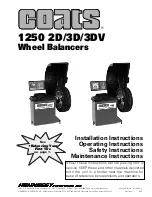
Important: Always read and follow the information box instructions.
• 1
¨
Balancing Your First Tire
1.
Turn the machine OFF then ON
(resets machine).
Note:
The machine wakes up using standard clip-
on wheel weight locations (Clip 1 & Clip 2) and
wheel dimensions.
2.
Mount a tire/wheel on the
balancer that will use standard
clip-on wheel weights.
Use the most appropriate mounting method.
3.
Always remove any weights
already attached to the wheel.
4.
Enter A & D wheel dimensions
using offset arm.
For Automatic Measurement — pull offset arm
out to the wheel, hold it still at clip-on weight
position against wheel flange, and wait for BEEP.
Return arm to home position.
Clip-on Weight Location — viewed on a cut-away
rim for clarification.
Figure 1 - Clip-On Weight Location
Note the value entry of A & D dimension.
5.
Enter Width wheel dimension.
For Manual Entry — Use plastic calipers to
measure wheel width. Press W key. Use keypad
to enter Width value (between 2.0 and 20.0
inches).
For Automatic Measurement — Lower hood.
Note value entry of W dimension.
6.
Lower the hood; wheel spins
and unbalances are measured
and displayed.
The corrective weight amount appears in the
weight display window for inboard and outboard
weight locations.
7.
Raise hood after tire stops
rotating.
Note:
Wait for wheel to stop before raising the
hood.
8.
Inboard center bar blinks.
Note:
If an inboard corrective weight is not
required, the wheel will stop at the outboard
corrective weight location, goto step 11.
9.
Attach inboard corrective
weight.
Attach specified weight amount at top-dead-
center on inside flange of wheel.
10.
Press NEXT; wheel rotates.
11.
Outboard center bar blinks.
12.
Attach outboard corrective
weight.
Attach specified weight amount at top-dead-
center on outside flange of wheel.
13.
Lower the hood to respin the
tire/wheel and check balance.
The weight readings should now be 0.00.
Note:
Throughout this manual tire dimensions
are referred to as A, W, and D, see figure 2.
Figure 2 - A, W, and D Tire Dimensions






















